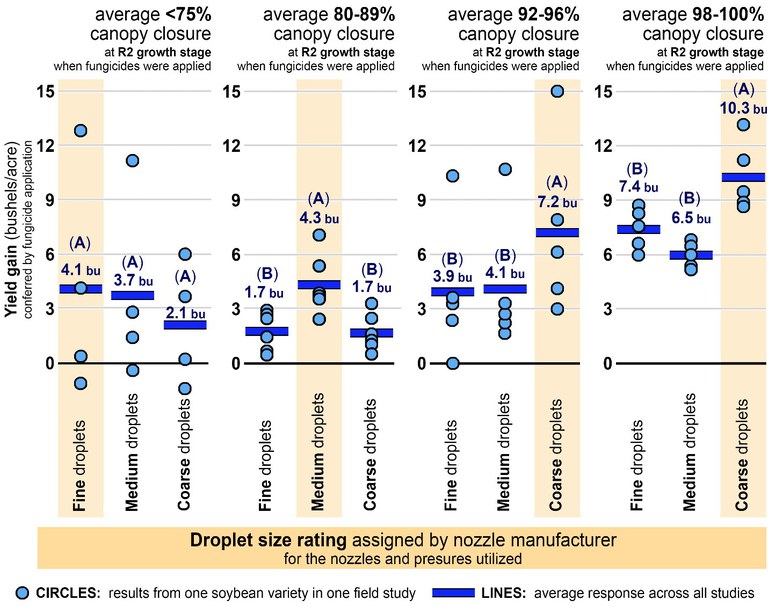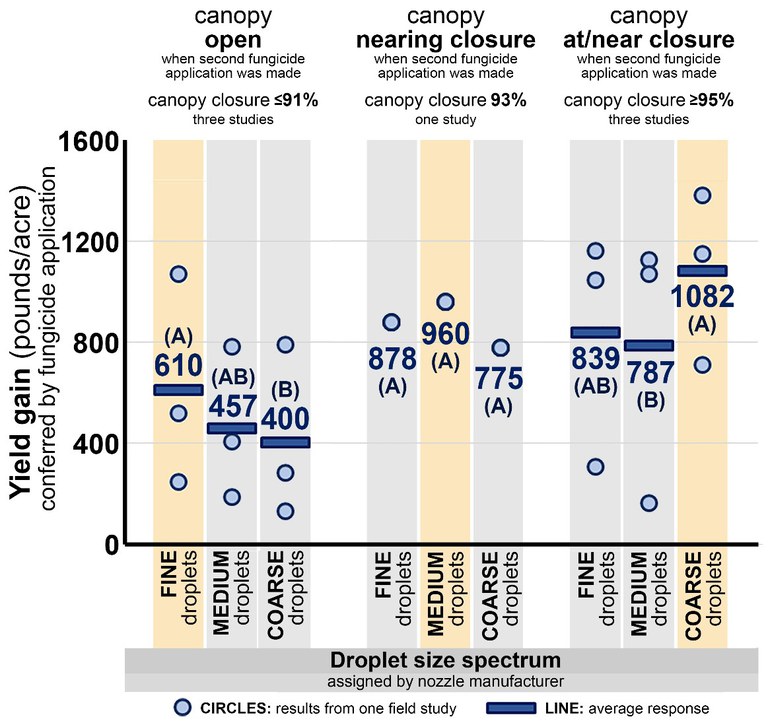Optimizing Fungicide Spray Droplet Size for Improved Disease Control and Yield
In the last few years, there has been significant discussion by private-sector and university agronomists on the importance of optimizing spray droplet size when applying herbicides. The discussion about spray droplet size has been focused nearly exclusively on herbicides, though, with little or no discussion about the impact of spray droplet size on the performance of other pesticides.
Does spray droplet size matter when applying fungicides? The standard recommendation is to apply fungicides with fine to medium droplets, but is that always true? Surprisingly, there is very little empirical data quantifying the impact of spray droplet size on fungicide performance on disease management in field crops.
The plant pathology research program in Carrington, in collaboration with the agronomists at the NDSU Robert Titus Research Farm in Oakes, has been conducting field studies to quantify the impact of spray droplet size on fungicide performance since 2017. Fungicide applications have been made with a tractor-mounted R&D sprayer equipped with a pulse-width modulation system from Capstan AG (Topeka, KS). Fungicides have been applied in a spray volume of 15 gal/ac and a driving speed of 4.0 mph, 6.0 mph, 6.7 mph, 8.9 mph, or 10.5 mph, depending on the study, with pulse width modified as needed to maintain a constant spray volume and constant driving speed across nozzles differing in output. Research has focused on management of white mold in soybeans and dry beans, Ascochyta blight of field peas, Ascochyta blight of chickpeas, and anthracnose of lentils.
The results indicate that fine to medium droplets do not always optimize fungicide performance. Fungicide droplet size must be calibrated relative to canopy characteristics, and significant yield gains can be achieved by optimizing fungicide spray droplet size.
For white mold in soybeans, optimizing fungicide spray droplet size relative to canopy characteristics increased the yield gain conferred by the fungicide by an average of 84%: optimizing fungicide droplet size nearly doubled the yield gain conferred by the fungicide. Fine to medium droplets optimized fungicide performance when the canopy was very open (average < 75% canopy closure when fungicides were applied); medium droplets optimized fungicide performance when the canopy was open (average 80-89% closure when fungicides were applied), and coarse droplets optimized fungicide performance when the canopy was at or near closure when fungicides were applied. A single application of the fungicide Endura (5.5 or 8.0 oz/ac) was applied at the R2 growth stage, and testing was conducted with TeeJet extended-range (XR) flat-fan nozzles. Parallel research conducted with Wilger Combo-Jet flat-fan nozzles conferred similar results.
The scatter plot below illustrates the impact of fungicide spray droplet size on white mold management in soybeans. Results are from field trials conducted in Oakes and Carrington from 2017 to 2020; circles denote the yield gain conferred by the fungicide in one replicated field study, and lines denote the average response across field studies. Testing was conducted on multiple soybean varieties differing in plant architecture and height. Average yield gains are presented together with letters denoting statistical separation (Tukey multiple comparison procedure; P < 0.05).
 Impact of fungicide spray droplet size on white mold management in soybeans
Impact of fungicide spray droplet size on white mold management in soybeans
Similar results have been observed for white mold in dry beans. In testing conducted with the same droplet size applied in two sequential fungicide applications (at early bloom and 10-14 days later), fine droplets optimized fungicide performance when the canopy was still open when the second fungicide application was made; medium droplets optimized fungicide performance when the canopy was nearing closure at the second fungicide application; and coarse droplets optimized fungicide performance when the canopy was at/near closure at the second fungicide application. The scatter plot below summarizes results from studies conducted with TeeJet nozzles in 2017 to 2020. Testing was conducted with multiple varieties differing in plant architecture: ‘Palomino’, ‘Vibrant’, ‘Falcon’ and ‘Lariat’ pintos. The fungicide Endura (8 oz/ac) was applied in both applications or rotated with Topsin (40 fl oz/ac), depending on the study. Average yield gains are presented together with letters denoting statistical separation (Tukey multiple comparison procedure; P < 0.10). Similar results were observed in studies conducted with black and navy beans.
 Canopy is a determining factor in droplet size for white mold management
Canopy is a determining factor in droplet size for white mold management
Additional yield gains from the fungicide can be expected in dry beans by calibrating fungicide spray droplet size relative to canopy characteristics at each fungicide application. Applying fine droplets at the first application (if the canopy is open) followed by coarse droplets at the second application (if the canopy is at or near closure) will almost certainly confer better disease control and higher yields than applying with the same droplet size twice. In field trials conducted in 2021, testing is being expanded to evaluate the impact of optimizing spray droplet size relative to canopy characteristics at each of the two fungicide applications (early bloom, 10-14 days later).
Results from droplet size research conducted on field peas, chickpeas, and lentils has produced similar results. When the targeted disease primarily impacts the upper canopy, fine droplets have optimized fungicide performance. When the targeted disease impacts the interior of the canopy, the optimum droplet size was contingent on canopy characteristics, with fine droplets optimal in an open canopy, medium droplets optimal in a canopy nearing closure, and coarse droplets optimal for applications made to a closed canopy. The only exception to this rule was observed with the use of chlorothalonil, which is an old contact fungicide that exhibits no systemic movement within plants. for chlorothalonil, preliminary results suggest that fine to medium droplets may optimize fungicide performance even when targeting a disease in the interior of a closed canopy. However, contact fungicides such as chlorothalonil are rarely used in field crops. The research conducted to-date indicates that for all of the modern fungicides, droplet size should be calibrated relative to location of the targeted tissues (top of the canopy versus interior of the canopy) and, for applications targeting the interior of the canopy, droplet size must be calibrated relative to canopy characteristics.
The results indicate that very high returns to investment can be achieved by optimizing droplet size for fungicides. Getting the spray droplet size right is cheap – only requiring proper nozzle selection and application pressure – and the optimal droplet size often confers yield gains of 50 to 100%. This research is ongoing, and results from the 2021 field season will be shown during the row crop tour at the end of the summer.
NDSU does not endorse commercial products or companies even though reference may be made to tradenames, trademarks or service names.
Michael Wunsch
Michael.Wunsch@ndsu.edu
Plant Pathologist


